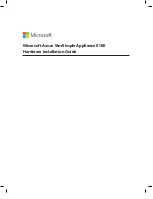
166
Appendix D
Configuration Files
The following rule configures Traffic Server to allow only the host associated with the IP address 11.11.1.1 to
deliver content directly into the cache.
dest_domain=. src_ip=11.11.1.1 method=PUSH action=allow
dest_domain=. method=PUSH action=deny
ftp_remap.config
The
ftp_remap.config
file in the Traffic Server’s
config
directory is used for FTP reverse proxy and
contains mapping rules that Traffic Server uses to direct any incoming FTP requests to the FTP server if the
requested document is a cache miss or is stale.
For information about using and configuring FTP reverse proxy, refer to
Chapter 5‚ Reverse Proxy and HTTP
Redirects
.
Format
Each line in the
ftp_remap.config
file contains a mapping rule in the format:
Traffic_Server_IPaddress:port ftp_server_IPaddress:port
where
Traffic_Server_IPaddress
is the IP address assigned to Traffic Server.
ftp_server_IPaddress
is the IP address assigned to the FTP server to which you want to redirect requests.
port
is the port number.
Example
In the following example, all FTP requests sent to Traffic Server’s IP address of 111.111.11.1 are directed to
the FTP server’s IP address 11.11.11.1 when a request is a cache miss or is stale.
111.111.11.1:7999 11.11.11.1:21
hosting.config
The
hosting.config
file lets you assign cache partitions to specific origin servers and/or domains so that
you can manage your cache space more efficiently, and restrict disk usage.
For step by step instructions on partitioning the cache according to origin servers and/or domains, refer to
Partitioning the cache according to origin server or domain‚ on page 61
.
IMPORTANT
If you enable the PUSH option, you must add a line similar to the following to prevent
unauthorized users from putting content in the cache.
IMPORTANT
After you modify the
ftp_remap.config
file, Traffic Manager has to reread the
configuration files. Run the
traffic_line -x
command. If you are running a cluster,
you need only run the command for one node; the changes will propagate.
NOTE
Before you can assign cache partitions to specific origin servers and/or domains, you
must partition your cache according to size and protocol in the
partition.config
file. For step by step instructions on partitioning your cache, refer to
Partitioning the
cache‚ on page 59
. For a description of the
partition.config
file, refer to
partition.config‚ on page 181
.
















































